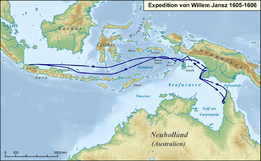 1. 1606 Click here for an account of Willem Janszoon. In November 1605 he sailed from Java towards the east past the southern coastline of New Guinea. Unable to make his way through the Torres Strait islands, he landed on Cape York pensinsula in February 1606, the first record of a European landing. Returned to Java without exploring further.
1. 1606 Click here for an account of Willem Janszoon. In November 1605 he sailed from Java towards the east past the southern coastline of New Guinea. Unable to make his way through the Torres Strait islands, he landed on Cape York pensinsula in February 1606, the first record of a European landing. Returned to Java without exploring further.
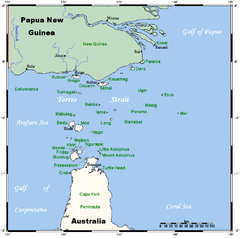 2. 1606 Click here for an account of Fernandes de Queiros. In February 1606 he sailed west from Peru, having been authorized by King Philip of Spain to search for Terra Australis. On May 14 1606 (Pentecost Sunday) he landed at Vanuatu, a distance of 2000 kilometres from Australia's eastern coast. He declared it to be La Austrialia del Espiritu Santo, in honour of King Philip's Austrian heritage.
2. 1606 Click here for an account of Fernandes de Queiros. In February 1606 he sailed west from Peru, having been authorized by King Philip of Spain to search for Terra Australis. On May 14 1606 (Pentecost Sunday) he landed at Vanuatu, a distance of 2000 kilometres from Australia's eastern coast. He declared it to be La Austrialia del Espiritu Santo, in honour of King Philip's Austrian heritage.
Somewhat madly, Queiros then declared they all would build a "New Jerusalem" while defending all the island's inhabitants from their enemies. Needless to say, the crew on his ship mutinied, and, while citing bad weather and bad health, they apparently kept him in his room. He sailed in his ship back to Mexico, trekked overland to the other side, and sailed back to Spain to make the announcement. In 1625 the name was altered by one letter when it was published in English as Australia del Espiritu Santo or "Southland of the Holy Spirit".
Back in 1606 his navigator Torres sailed north to the Philippines with new captain de Prado. He arrived in Manila via the south coast of New Guinea, possibly sighting the hills of Cape York, but if so, no record was made. In 1607 Torres documented his voyage in Spanish,then subsequently disappeared from history. His Spanish account remained in Spanish archives in Manila until 1762, when translated into English.
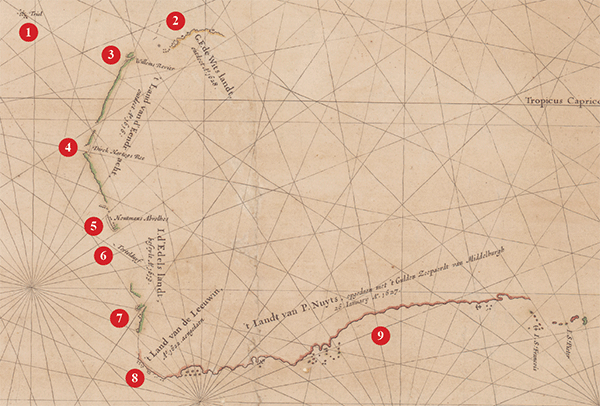 3. 1628 Click here for a Dutch map in 1628. From 1616 starting with Dirk Hartog, a section of Australia's south west coastline was mapped by Dutch explorers sailing over the Indian Ocean towards Java. In 1627, more than 1,500km of Australia's southern coastline was mapped from Albany, Western Australia, to Ceduna, South Australia, by François Thijssen. He named the area Nuyt's Land after Pieter Nuyt, an important passenger, before apparently returning west and sailing north to Java.
3. 1628 Click here for a Dutch map in 1628. From 1616 starting with Dirk Hartog, a section of Australia's south west coastline was mapped by Dutch explorers sailing over the Indian Ocean towards Java. In 1627, more than 1,500km of Australia's southern coastline was mapped from Albany, Western Australia, to Ceduna, South Australia, by François Thijssen. He named the area Nuyt's Land after Pieter Nuyt, an important passenger, before apparently returning west and sailing north to Java.
He then sailed along the bottom of the Indian Ocean, see that red line, bumping into the southern coast of Tasmania, which he mapped and named "Van Diemen's Land" after the governor, and, thinking it was a sizeable land mass, he planted the Dutch Flag, to claim it.
He then explored part of New Zealand but thought the land was connected, somehow, to Staten Land at Argentina South America, and named it "Staten Landt". (Three years later Dutch cartographers renamed it "Nova Zeelandia" or New Zealand).
He then sailed up to Tonga, over the top of New Guinea, and back to Java. In 1644 he sailed east from Java, see that blue line, underneath New Guinea, sighted Australia, which he now named Nova Hollandia (New Holland in English).
He looked for a way through to the east coast of New Holland, but too many reefs and stuff. So, pretty disappointed apparently, mapped the northern and western part only.
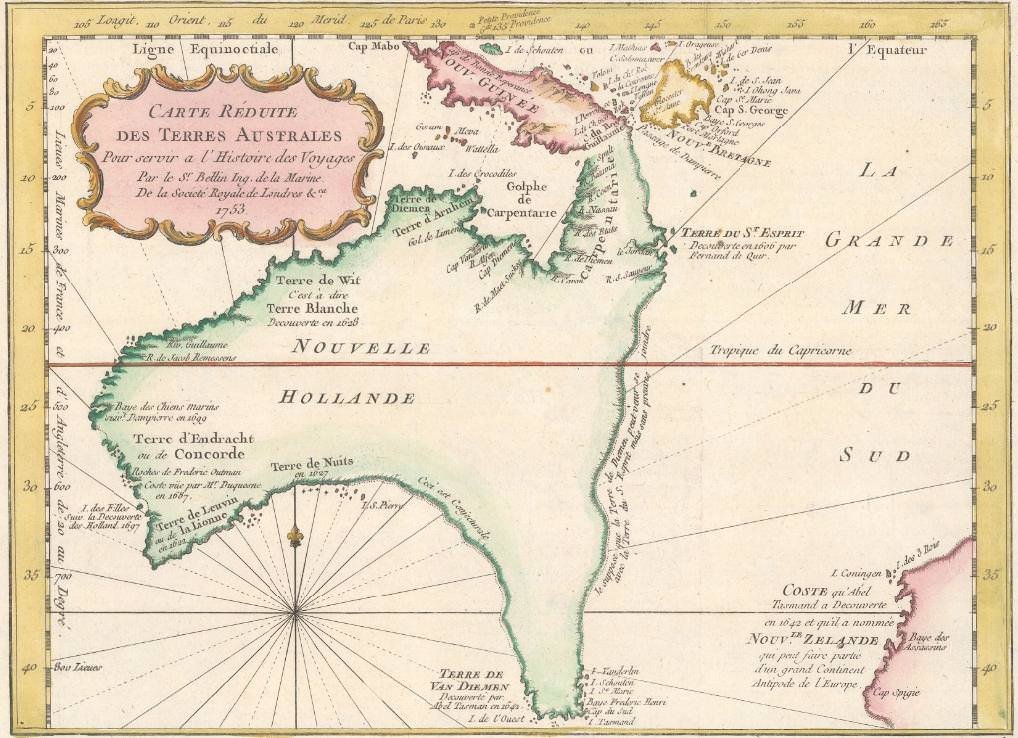 5. 1753 Click here for an English translation (and advertisement) for a fairly famous French chart of New Holland (Terra Australis) in 1753. It shows it joined to Van Diemen's Land (Tasmania) in the south, its north-east tip joined to New Guinea, and its still uncharted eastern coastline including de Quiros's Land of the Holy Spirit (Vanuatu chart) from 1606.
5. 1753 Click here for an English translation (and advertisement) for a fairly famous French chart of New Holland (Terra Australis) in 1753. It shows it joined to Van Diemen's Land (Tasmania) in the south, its north-east tip joined to New Guinea, and its still uncharted eastern coastline including de Quiros's Land of the Holy Spirit (Vanuatu chart) from 1606.
In Pilgrim Progress styled irony, those French words along the eastern side of the map say in English "I suppose that the land of Diemen can join with the land of Terre du St Esprit, but this is without proof." 
 6. 1762 Click here for an account of Torres Strait, named by Scotsman Alexander Dalrymple after he translated Torres's Spanish records he located in Manila in the Philippines.
6. 1762 Click here for an account of Torres Strait, named by Scotsman Alexander Dalrymple after he translated Torres's Spanish records he located in Manila in the Philippines.
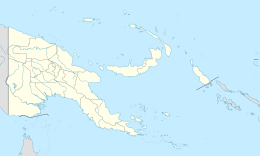 7. 1767 Click here for an account of Antoine de Bougainville in 1767, sent by France to search for Terra Australis. Sailing from Nantes in France, he sailed beneath South America, reached Espiritu Santo in the Pacific Ocean, but apparently breakers forced his ship north and east before he could reach the east coast. Sailed through the Solomon Islands, named Bougainville Island in New Guinea, then on to Java, and back to France, circumnavigating the world.
7. 1767 Click here for an account of Antoine de Bougainville in 1767, sent by France to search for Terra Australis. Sailing from Nantes in France, he sailed beneath South America, reached Espiritu Santo in the Pacific Ocean, but apparently breakers forced his ship north and east before he could reach the east coast. Sailed through the Solomon Islands, named Bougainville Island in New Guinea, then on to Java, and back to France, circumnavigating the world.
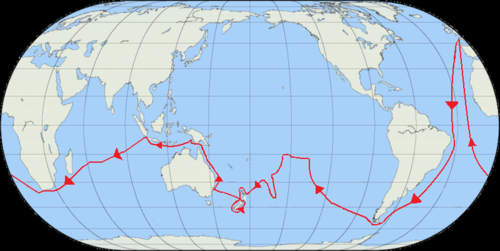 8. 1770 Click here for an account of James Cook, sent by England, ostensibly to track the path of Venus across the face of the Sun from the island of Tahiti in the Pacific Ocean. Sailing from England in 1769, he sailed beneath South America, reached Tahiti, tracked the Venus path, then opened sealed orders that instructed him to sail south to explore for Terra Australis. Reached the islands of New Zealand, and mapped them both. Exploring west in 1770, reached Point Hicks in Victoria. Sailed north, mapping the entire eastern coastline, naming places like Botany Bay, Port Jackson, and Moreton Bay. Reached Cape York, claiming the whole eastern land in the name of the Crown, and with the name New South Wales. Sailed through the narrow Endeavour Strait, it was only 800 metres wide at one point, and only 5½ metres deep at its western end. Sailed on to Java, and back to England.
8. 1770 Click here for an account of James Cook, sent by England, ostensibly to track the path of Venus across the face of the Sun from the island of Tahiti in the Pacific Ocean. Sailing from England in 1769, he sailed beneath South America, reached Tahiti, tracked the Venus path, then opened sealed orders that instructed him to sail south to explore for Terra Australis. Reached the islands of New Zealand, and mapped them both. Exploring west in 1770, reached Point Hicks in Victoria. Sailed north, mapping the entire eastern coastline, naming places like Botany Bay, Port Jackson, and Moreton Bay. Reached Cape York, claiming the whole eastern land in the name of the Crown, and with the name New South Wales. Sailed through the narrow Endeavour Strait, it was only 800 metres wide at one point, and only 5½ metres deep at its western end. Sailed on to Java, and back to England.
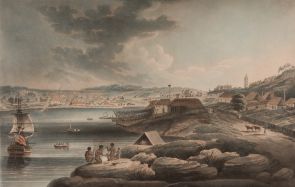 9. 1788 Click here for the naming of Sydney. Click here for the life of Governor Arthur Phillip. On 26 January 1788, Phillip's convict fleet entered Port Jackson (in Phillip's words "the finest harbour in the world"), and then the masters of ships ruled off their logs with the words 'moored in Sydney Cove'. Phillip had named it after Lord Sydney, the British Secretary of State for the Home Department, and Phillip's immediate boss.
9. 1788 Click here for the naming of Sydney. Click here for the life of Governor Arthur Phillip. On 26 January 1788, Phillip's convict fleet entered Port Jackson (in Phillip's words "the finest harbour in the world"), and then the masters of ships ruled off their logs with the words 'moored in Sydney Cove'. Phillip had named it after Lord Sydney, the British Secretary of State for the Home Department, and Phillip's immediate boss.Click here for the timelines of two men, Hunter and King who arrived with Phillip in 1788, and John MacArthur who arrived in 1790 to become "Father of the Australian Sheep Industry".
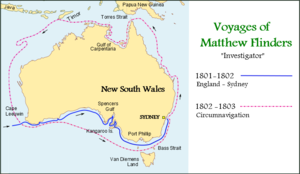 10. 1798-1803 Click here for an account of Matthew Flinders. In 1798, together with George Bass, he explored Van Diemen's Land (Tasmania) confirming that it was a small island and not joined to the mainland as had been previously presumed. In 1799 he explored Moreton Bay and Redcliffe, the future site for Brisbane. In 1800 he sailed back to London (via Cape Horn in South America).
10. 1798-1803 Click here for an account of Matthew Flinders. In 1798, together with George Bass, he explored Van Diemen's Land (Tasmania) confirming that it was a small island and not joined to the mainland as had been previously presumed. In 1799 he explored Moreton Bay and Redcliffe, the future site for Brisbane. In 1800 he sailed back to London (via Cape Horn in South America).In 1801 he returned to Sydney, mapping the final piece of Australia's southern coastline. In 1802, he became the first explorer to actually circumnavigate Australia, naming it with that name, arriving back in Sydney in 1803.